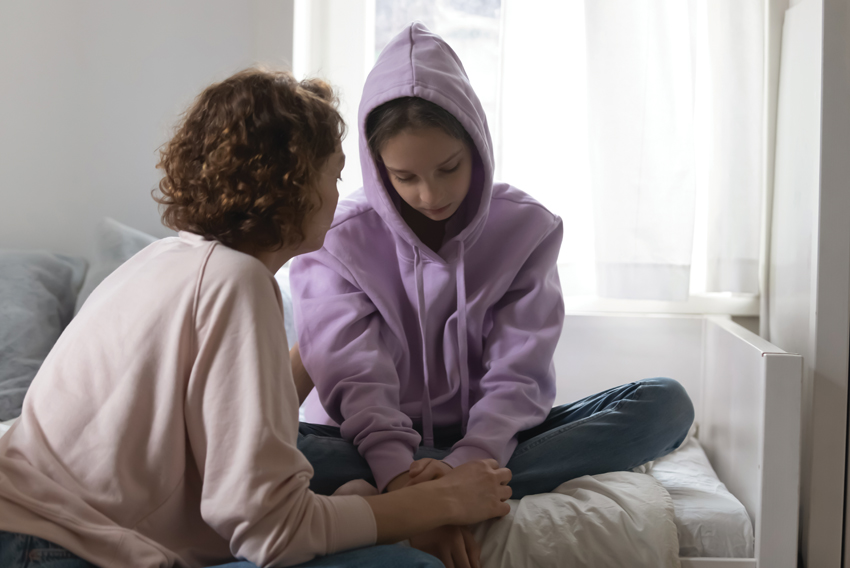One family's story of school non-attendance
Reprinted from the The Vibes Are Off: Young People, Anxiety and Depression issue of Visions Journal, 2025, 21 (1), pp. 10-11

My youngest child was anxious from a young age, but we never recognized from her behaviour that she was experiencing anxiety. She made friends easily, loved to play and loved going to preschool, then school.
The problem was that getting to the places she loved was difficult, sometimes impossible. Right before leaving the house, something would shift. She’d be uncomfortable in her clothes or feared she’d be late. If she thought we’d be even one second late, she literally couldn’t leave the house. But if we were able to get her to the activity, she almost always enjoyed herself and often didn’t want to leave.
Other signs of anxiety we never recognized were her perfectionism and her fear of being singled out. So much of her experience was internal, and we only learned about it later.
Fast forward to Grade 8. Elementary school had been a breeze. My daughter had a good group of friends and never struggled academically. The transition to high school seemed OK at first. She’d been adamant about attending an accelerated academic program. Initially, she loved it and was diligent with doing her homework. But we could see her stress increasing to an unhealthy level.
Non-attendance started halfway through the year. Her stress from trying to keep up with all the tasks became too much. I remember watching my kid painstakingly colour a socials assignment for hours, then not attend class the following day because she hadn’t finished. No amount of logical reasoning made a difference.
My partner and I reassured our child that learning was the most important thing, not grades. I even convinced her to go to a counsellor, but after a few sessions, that person was no longer available. This caused a rupture in their developing rapport and a general distrust of counselling.
I watched my once-happy child sink deeper and deeper, unable to do anything other than school. She refused invitations to do fun things with her friends because she felt she had no time.
A painful change
In January 2020 my child missed school because she was panicked about not finishing an assignment. She spent the day at home working on it and returned the following day planning to hand in her finished work. My sensitive, conscientious student was confronted by her teacher and called out of another class, accused of not having completed the work.
This might have been upsetting to some students, but it was traumatizing for my daughter. She did not attend high school for the rest of the year.
For weeks we had no idea what had happened. She fell further and further behind. My stress was off the charts as I tried to get her to go back. She couldn’t articulate why she found it so hard, and we began focusing on things she could do: walking the dog, participating in her extracurricular activities of sport and music.
I was a mess. I remember bumping into a neighbourhood acquaintance who asked how I was. In my fragile state I burst into tears. I was embarrassed by my vulnerability and oversharing. There seemed to be no middle ground. I either created a facade that everything was OK or I shared so much I probably made people uncomfortable.
I felt responsible and powerless. What was wrong? Why wouldn't or couldn’t she go? We spoke regularly to the school counsellor and even arranged for him to visit the house. My child refused to join us. School staff told us they’d never experienced such resistance from a student
But wasn’t this their job? Surely my kid wasn’t the only one? Now what could we do? She even refused to interact with our pediatrician.
I sought counselling for myself. I became more aware of my own anxiety and how it was fuelling our interactions. I saw that my child’s mental health was the most important issue to focus on. Attending school would only be possible once she reached a healthier place.
As a result, I brought less pressure to our interactions. I didn’t try to use every opportunity we had together to talk about getting her back to school. I was able to enjoy our time together more because I wasn’t always calculating when I could work in a problem-solving conversation.
With practice, I started to broach uncomfortable topics. Learning how to validate my daughter’s experiences and emotions without jumping to problem solving was new and continues to be a challenge for me.
New strategies
The COVID pandemic was positive for my child. When she eventually returned to school, everyone else had also been away. Of course, other challenges emerged. We initially thought our daughter was attending remotely. It wasn’t until several months later that we learned she didn’t attend most of her classes.
Not one teacher let us know. Our child was so ashamed, she pretended to be doing the work. We subsequently found out she also has inattentive ADHD, which makes virtual learning incredibly challenging.
She began to feel better that summer. School was her major trigger, so it was a natural time to feel more relaxed. She began anti-anxiety medication and made a plan with her pediatrician to return to school.
Fall of 2020 was a gradual return, with some virtual and some in-person classes. We set up extra support to make the transition successful. This included regular check-ins with her and her teachers, tutoring and executive function coaching. Even with that support, it was not easy.
Many factors helped our child’s reintegration to school. We deepened our communication skills as parents and began to:
- Practise deep listening and learning when not to push too much
- Accept that there would be good days and bad days; on the bad days we’d support her the best we could
- Remind ourselves of our own tendency to get anxious and catastrophize when she missed a day of school
Understanding that she couldn’t go—not something she was actively choosing—helped us to remember to offer support and not always push for solutions. I learned to say things like, “I am sorry things are so hard right now. I know how hard you are trying.”
Acceptance and advocacy
Anxiety never disappears, and if it reaches a tipping point, coping won’t work in that moment. The only thing to do is wait for it to pass. With time, practice and growth, my child attended more consistently and bounced back more quickly after an absence or difficult interaction.
School and teacher support was instrumental. Yet knowledge, skills and accommodations were uneven. Because my child is bright, high-achieving, quiet and hides her struggles, some teachers challenged her need for accommodation and my requests to be involved. I’ve had to navigate constant advocacy within the school.
I’m grateful my child has come through many of her challenges and has found areas of interest to pursue. Our discovery that she is autistic, with ADHD, has helped us all create a supportive environment to help her thrive.
About the author
Leila is a parent with lived experience. Her children, her greatest teachers, have struggled with their mental health
